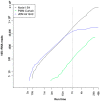Real-Time Culture-Independent Microbial Profiling Onboard the International Space Station Using Nanopore Sequencing
- PMID: 33467183
- PMCID: PMC7830261
- DOI: 10.3390/genes12010106
Real-Time Culture-Independent Microbial Profiling Onboard the International Space Station Using Nanopore Sequencing
Abstract
For the past two decades, microbial monitoring of the International Space Station (ISS) has relied on culture-dependent methods that require return to Earth for analysis. This has a number of limitations, with the most significant being bias towards the detection of culturable organisms and the inherent delay between sample collection and ground-based analysis. In recent years, portable and easy-to-use molecular-based tools, such as Oxford Nanopore Technologies' MinION™ sequencer and miniPCR bio's miniPCR™ thermal cycler, have been validated onboard the ISS. Here, we report on the development, validation, and implementation of a swab-to-sequencer method that provides a culture-independent solution to real-time microbial profiling onboard the ISS. Method development focused on analysis of swabs collected in a low-biomass environment with limited facility resources and stringent controls on allowed processes and reagents. ISS-optimized procedures included enzymatic DNA extraction from a swab tip, bead-based purifications, altered buffers, and the use of miniPCR and the MinION. Validation was conducted through extensive ground-based assessments comparing current standard culture-dependent and newly developed culture-independent methods. Similar microbial distributions were observed between the two methods; however, as expected, the culture-independent data revealed microbial profiles with greater diversity. Protocol optimization and verification was established during NASA Extreme Environment Mission Operations (NEEMO) analog missions 21 and 22, respectively. Unique microbial profiles obtained from analog testing validated the swab-to-sequencer method in an extreme environment. Finally, four independent swab-to-sequencer experiments were conducted onboard the ISS by two crewmembers. Microorganisms identified from ISS swabs were consistent with historical culture-based data, and primarily consisted of commonly observed human-associated microbes. This simplified method has been streamlined for high ease-of-use for a non-trained crew to complete in an extreme environment, thereby enabling environmental and human health diagnostics in real-time as future missions take us beyond low-Earth orbit.
Keywords: bacterial identification; field-deployable methods; in-situ analysis; nanopore sequencing; spaceflight.
Conflict of interest statement
S.J., D.J.T., and D.S. are employed by Oxford Nanopore Technologies, which manufactures and markets the MinION sequencing technology. These two authors supported method development. Other authors declare no conflict of interest.
Figures







Similar articles
-
Off Earth Identification of Bacterial Populations Using 16S rDNA Nanopore Sequencing.Genes (Basel). 2020 Jan 9;11(1):76. doi: 10.3390/genes11010076. Genes (Basel). 2020. PMID: 31936690 Free PMC article.
-
Crewmember microbiome may influence microbial composition of ISS habitable surfaces.PLoS One. 2020 Apr 29;15(4):e0231838. doi: 10.1371/journal.pone.0231838. eCollection 2020. PLoS One. 2020. PMID: 32348348 Free PMC article.
-
Characterization of the total and viable bacterial and fungal communities associated with the International Space Station surfaces.Microbiome. 2019 Apr 8;7(1):50. doi: 10.1186/s40168-019-0666-x. Microbiome. 2019. PMID: 30955503 Free PMC article.
-
Current Progression: Application of High-Throughput Sequencing Technique in Space Microbiology.Biomed Res Int. 2020 Jun 20;2020:4094191. doi: 10.1155/2020/4094191. eCollection 2020. Biomed Res Int. 2020. PMID: 32685480 Free PMC article. Review.
-
Space radiation dosimetry in low-Earth orbit and beyond.Nucl Instrum Methods Phys Res B. 2001 Sep;184(1-2):255-94. doi: 10.1016/s0168-583x(01)00748-0. Nucl Instrum Methods Phys Res B. 2001. PMID: 11863032 Review.
Cited by
-
Spaceflight Induces Strength Decline in Caenorhabditis elegans.Cells. 2023 Oct 17;12(20):2470. doi: 10.3390/cells12202470. Cells. 2023. PMID: 37887314 Free PMC article.
-
The Development of a 3D Printer-Inspired, Microgravity-Compatible Sample Preparation Device for Future Use Inside the International Space Station.Micromachines (Basel). 2023 Apr 26;14(5):937. doi: 10.3390/mi14050937. Micromachines (Basel). 2023. PMID: 37241562 Free PMC article.
-
Predicting how varying moisture conditions impact the microbiome of dust collected from the International Space Station.Microbiome. 2024 Sep 10;12(1):171. doi: 10.1186/s40168-024-01864-3. Microbiome. 2024. PMID: 39256883 Free PMC article.
-
Perspectives and Benefits of High-Throughput Long-Read Sequencing in Microbial Ecology.Appl Environ Microbiol. 2021 Aug 11;87(17):e0062621. doi: 10.1128/AEM.00626-21. Epub 2021 Aug 11. Appl Environ Microbiol. 2021. PMID: 34132589 Free PMC article. Review.
-
Nanopore Sequencing Provides Rapid and Reliable Insight Into Microbial Profiles of Intensive Care Units.Front Public Health. 2021 Aug 27;9:710985. doi: 10.3389/fpubh.2021.710985. eCollection 2021. Front Public Health. 2021. PMID: 34513786 Free PMC article.
References
-
- Pierson D.L. Microbial contamination of spacecraft. Gravitat. Space Biol. Bull. 2001;14:1–6. - PubMed
-
- Ferguson J.K., Taylor G.R., Mieszkuc B.J. Microbiological Investigations. In: Johnston R.S., Dietlein L.F., Berry C.A., editors. Biomedical Results of Apollo. National Aeronautics and Space Administration; Washington, DC, USA: 1975.
-
- Taylor G.R., Graves R.C., Brockett R.M., Ferguson J.K., Mieszuc B.J. Skylab Environmental and Crew Microbiology Studies. In: Johnston R.S., Dietlein L.F., editors. Biomedical Results from Skylab. National Aeronautics and Space Administration; Washington, DC, USA: 1977.
-
- Pierson D.B., Ott C.M., Bruce R., Castro A.V., Mehta S.K. American Institute of Aeronautics and Astronautics Meeting Papers, Proceedings of the 41st International Conference on Environmental Systems, International Conference on Environmental Systems (ICES), Portland, OR, USA, 17 July 2011. American Institute of Aeronautics and Astronautics; Reston, VA, USA: 2012. Microbiological Lessons Learned From the Space Shuttle; p. 5266.
Publication types
MeSH terms
Substances
Grants and funding
LinkOut - more resources
Full Text Sources
Other Literature Sources
Miscellaneous

